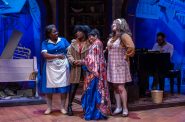About New York… six things I’ve been meaning to tell you
Cindy Sherman, Frank Sinatra High, PS1, Whitney Biennial/remarkable Morans, How to Succeed, Life in the East Village.
The Milwaukee Symphony at Carnegie Hall on May 11 was the main thing about our New York trip, but not the only thing.
1. I first saw Cindy Sherman‘s photos at a gallery in New York in 1984. In her staged “movie stills,” she played an assortment of stereotypical movie females from the 1940s and ’50s. Lit in film-noir style and steaming with drama, those photos at once critiqued and celebrated pop-culture portrayals of women. They caused a sensation.
Sherman remains a sensation. Her massive retrospective at the Museum of Modern art showed that she has been relentless over the decades. Sherman has been her own model throughout and become increasingly ambitious and subtle in her role-play. As she’s aged, so have her imaginary subjects. The most dazzling images among the hundreds at MOMA showed the photographer as a variety of society matrons, shot as if in sumptuous official portraits printed very large. They’re surrounded by luxury, exquisitely and expensively coifed and made-up, and wrapped in haute couture. But the pitiless lens reveals the advance of time. Pick your response, or mix them up: aesthetic appreciation of the gorgeous, voyeurism, schadenfreude, envy, resignation to the fate that awaits us all.
The Sherman show closed June 11, but MOMA’s terrific exhibition website is still up. You can see every piece in the show there. Do visit it, especially if you don’t know Sherman’s work. It’s essential as the central body of work documenting and probing Western high culture’s 20th-century obsession with identity and how we create it.

At Frank Sinatra High School. Maybe my enthusiasm won them over. Photo by Shay Sharon, Frank Sinatra High School of the Arts.
2. Thanks to Tony Bennett’s office, I spoke to three of Ken Lieberson’s music theory classes at the Frank Sinatra High School of the Arts, a New York City public school in Astoria, Queens. I wasn’t sure how it would go. It was, after all the middle of May with summer break around the corner, and 30 high school sophomores stuck in a room with a guest speaker who meant nothing to them. On top of all that, an NYPS firewall prevented access to YouTube, where my musical and film examples resided. And on top of that, the topic was the origins of American popular song in minstrelsy, a minefield of race issues, delivered to a melting pot of New York kids.
Formula for disaster? Maybe, but put it all together and something went right. I had three classes of the most courteous, charming high school kids you could imagine. They were perfectly willing to discuss the nuances of racial stereotypes and the differences between them in 1880 and now. Ernest Hogan (1860-1909), now forgotten but perhaps the greatest star of minstrelsy, was the centerpiece of the discussion. This fascinating and uncommonly talented black man — a producer and songwriter in addition to being an electric performer — wrote All Coons Look Alike to Me, the most notorious of all “coon songs” and the starting gun of Ragtime. The students found all this interesting and tried to get their heads around how this could have happened. They were so open to and remarkably capable of putting themselves in Hogan’s place way back when.
It was such a pleasure to be around these kids. Near the end of the second class, a dozen girls harmonized Embraceable You for me. What a beautiful way to spend a Friday afternoon. I hope to go back some time.
I got to speak about American popular song at Frank Sinatra High School. Doesn’t get cooler than that.
3. On the way back to Manhattan from the high school, we encountered entropy distilled in the work of Italian conceptualist Lara Favaretto. Favaretto’s show is up through Sept. 10 in MOMA’s great PS1 space, 22-25 Jackson Ave. at 46th Ave., Long Island City, a very easy subway commute from Manhattan.
Favaretto (b. 1973) gives us the bad news — that we and the universe are inevitably, relentlessly, running down — in an astonishing variety of ways. Ranks of large compressed air cylinders inflate party blow-ups either randomly or in some inscrutable pattern. The cylinders will empty by the time the show closes. A large cube, made entirely of confetti (many-hued, but mostly green), slowly sheds its substance onto the gallery floor. Five giant car-wash brushes spin gaily at intervals — and slowly destroy themselves through friction of one against the other and against the gallery wall. Favaretto’s wicked humor relieves the gloom. Might as well drink a toast, have a laugh and pitch the champagne glasses into the fireplace as the world ends.
For more, read Eric Russ’ excellent review in Highbrow Magazine.
4. The visual art part of the Whitney Biennial underwhelmed me, but we happened to be at the Whitney Sunday afternoon, as pianist-composer Jason Moran and singer-composer Alicia Hall Moran performed Moran’s Bleed. Moran lead an ensemble comprising Hall Moran, guitarist Bill Frisell, bassist Tarus Mateen, and drummer Jamire Williams. In the segment I heard, they wove music with and around text from Asali Solomon’s Cold Water for Blood Stains, about finding the way to Gee’s Bend and getting to know the quilters there.
I know, that doesn’t sound so promising, and I didn’t intend to stick around for all 45 minutes. But Hall Moran’s irresistible charisma, tonal beauty and phrasing held me there. So did Moran’s heady way of weaving seamlessly among driving, blues-inflected jazz, the spaciest free-form sound sculpting, specifically scored modernism, improvisational rave-ups and glosses on Poor Wayfarin’ Stranger. The Morans make highly intellectual music that is loaded with soul and impossible without virtuoso skill. They would be a very good match for Present Music.
5. We had made no plans for Sunday night, but couldn’t bear to let a New York night pass idly. So we joined the Times Square throngs and stepped up to the TKTS booth and made a last-minute impulse buy: 40% off How to Succeed in Business Without Really Trying at the Al Hirschfield Theater, a venerable house that seats about 2000.
An hour later, I was wishing I had that $170 back. The Frank Loesser musical, from 1961, hasn’t aged well; the idea of spending an entire career climbing a corporate ladder teeming with unproductive drones sounds remote these days. The obvious point of reference now is Mad Men, but How to Succeed paints with a much broader brush. It has as much to do with corporate life in the 1960s as Li’l Abner had to do with rural American life. And the poor women of the World Wide Wicket Corp., who aspire to nothing more than keeping the executive hubby’s dinner warm for when he comes home. If he comes home.
The show was still kind of fun, with a high-energy cast and a nifty grid of vertical cubicles by Derek McLane. The show is lavish. I did not understand why Tammy Blanchard constantly staggered about as if drunk while playing sexpot Hedy La Rue, but otherwise the cast was fine in an energetic, cartoonish way that fits the show.
The young fellow was just fine in the role, but nothing in his work merited the ecstatic screaming that answered his every move. After a few minutes of this, we recognized the screaming as emanating from early pre-teen females.
What was that guy’s name again? Nick Jonas? Isn’t there something called the Jonas Brothers?
Ooooohhhh, I get it.
6. I’ve visited New York many times and always stayed in hotels. This time, a friend lent us her apartment while she was in Florida. It’s in the East Village, bordering Tompkins Square Park. Twenty years ago, you would never have wanted to be in this neighborhood. Now it is endlessly charming, with vibrant street life and excellent, friendly, cheap restaurants everywhere. We enjoyed getting a taste of everyday living in New York. Hot restaurant tips: 7A, at Seventh Avenue and A Street; how they stay open 24 hours and make such consistently fine and imaginative food is beyond me. Great for breakfast, especially. Cafe Mogador, some of the best Eastern Mediterranean food you’ll find anywhere. At 101 St. Mark’s Place, No. 1.
Art
-
Winning Artists Works on Display
 May 30th, 2024 by Annie Raab
May 30th, 2024 by Annie Raab
-
5 Huge Rainbow Arcs Coming To Downtown
 Apr 29th, 2024 by Jeramey Jannene
Apr 29th, 2024 by Jeramey Jannene
-
Exhibit Tells Story of Vietnam War Resistors in the Military
 Mar 29th, 2024 by Bill Christofferson
Mar 29th, 2024 by Bill Christofferson
Theater
-
‘The Treasurer’ a Darkly Funny Family Play
 Apr 29th, 2024 by Dominique Paul Noth
Apr 29th, 2024 by Dominique Paul Noth
-
Rep’s Nina Simone Play a Puzzle
 Apr 23rd, 2024 by Dominique Paul Noth
Apr 23rd, 2024 by Dominique Paul Noth
-
Skylight’s ‘Eternity’ Is a Slam Bang Show
 Apr 15th, 2024 by Dominique Paul Noth
Apr 15th, 2024 by Dominique Paul Noth



























